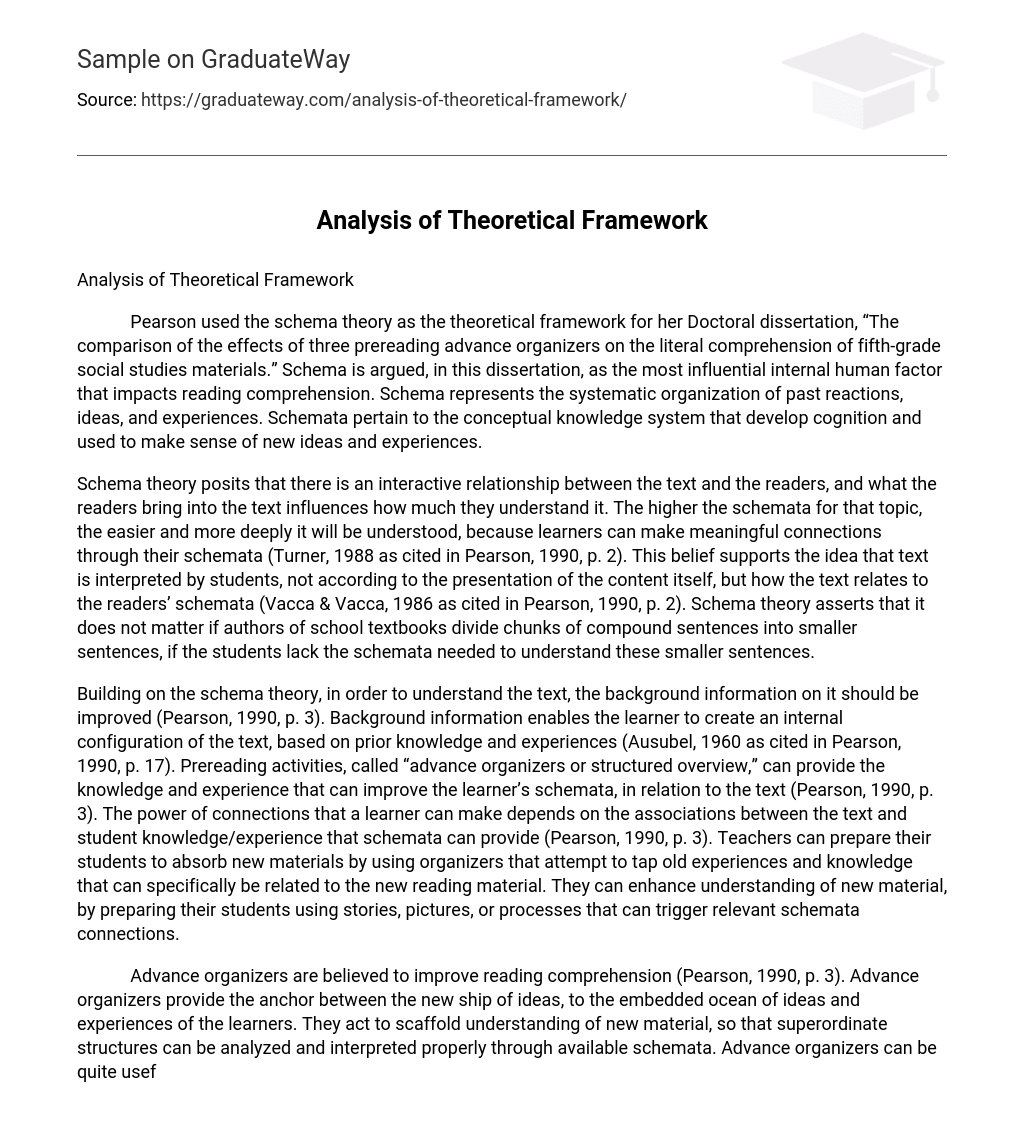Pearson used the schema theory as the theoretical framework for her Doctoral dissertation, “The comparison of the effects of three prereading advance organizers on the literal comprehension of fifth-grade social studies materials.” Schema is argued, in this dissertation, as the most influential internal human factor that impacts reading comprehension. Schema represents the systematic organization of past reactions, ideas, and experiences. Schemata pertain to the conceptual knowledge system that develop cognition and used to make sense of new ideas and experiences.
Schema theory posits that there is an interactive relationship between the text and the readers, and what the readers bring into the text influences how much they understand it. The higher the schemata for that topic, the easier and more deeply it will be understood, because learners can make meaningful connections through their schemata (Turner, 1988 as cited in Pearson, 1990, p. 2). This belief supports the idea that text is interpreted by students, not according to the presentation of the content itself, but how the text relates to the readers’ schemata (Vacca & Vacca, 1986 as cited in Pearson, 1990, p. 2). Schema theory asserts that it does not matter if authors of school textbooks divide chunks of compound sentences into smaller sentences, if the students lack the schemata needed to understand these smaller sentences.
Building on the schema theory, in order to understand the text, the background information on it should be improved (Pearson, 1990, p. 3). Background information enables the learner to create an internal configuration of the text, based on prior knowledge and experiences (Ausubel, 1960 as cited in Pearson, 1990, p. 17). Prereading activities, called “advance organizers or structured overview,” can provide the knowledge and experience that can improve the learner’s schemata, in relation to the text (Pearson, 1990, p. 3). The power of connections that a learner can make depends on the associations between the text and student knowledge/experience that schemata can provide (Pearson, 1990, p. 3). Teachers can prepare their students to absorb new materials by using organizers that attempt to tap old experiences and knowledge that can specifically be related to the new reading material. They can enhance understanding of new material, by preparing their students using stories, pictures, or processes that can trigger relevant schemata connections.
Advance organizers are believed to improve reading comprehension (Pearson, 1990, p. 3). Advance organizers provide the anchor between the new ship of ideas, to the embedded ocean of ideas and experiences of the learners. They act to scaffold understanding of new material, so that superordinate structures can be analyzed and interpreted properly through available schemata. Advance organizers can be quite useful for content area reading, because of the conceptual load they contain. There are several kinds of advance organizers, with mixed results on their effectiveness in improving reading comprehension and retention. Social studies particularly present diverse unknown concepts and topics, which is why Pearson used this subject to understand the impact of organizers on reading comprehension.
Pearson reviewed literature and discovered that none of them compared the effectiveness of graphic organizers to one another. She decided to compare the impact of three organizers on reading comprehension- verbal concept organizer, a graphic organizer, and a problematic situation- and to also compare their results with a control class that used no organizer, using a specific reading selection. She wanted to know, in particular, if any specific advance organizer is more effective than another. She also examined the superiority of advance organizers to using no advance organizers at all. These research aims led to her two research questions. These research questions test the schemata theory’s primary contention that providing a framework for comprehending new text can be a strategic tool in improving comprehension and recall better than without providing any comprehension framework at all.
Reference
Pearson, C.L. P. (1990). The comparison of the effects of three prereading advance organizers on the literal comprehension of fifth-grade social studies materials (Doctoral Dissertation, The University of Tennessee, Knoxville).





